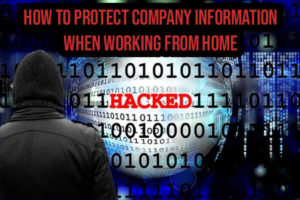
With cyberthieves active during COVID-19, organizations are urged to maintain a heightened state of alert as cybercriminals seek to exploit Covid-19 concerns. There are security steps that can be taken to ensure you are fully protecting client data whether working in the office or a remote location.
To guard against cyberthreats, employers should consider:
- Requiring all employee devices to be equipped with the employer-provided security software and the latest manufacturer software updates prior to permitting access to any remote systems;
- Requiring multifactor authentication upon each login to a company portal;
- Only allowing remote access through a virtual private network (VPN) with strong end-to-end encryption;
- Prohibiting working from public places, such as coffee shops or on public transportation, where third parties can view screens and printed documents;
- Prohibiting use of public WiFi, and requiring the use of secure, password-protected home WiFi or hotspots.
- Imposing additional credentialing with respect to the ability to download certain sensitive data.
The following are the basic steps for protection that everyone, especially any business handling sensitive data, should use:
- Anti-virus software
Although details may vary between commercial products, anti-virus software scans computer files or memory for certain patterns that may indicate the presence of malicious software (also called malware). Anti-virus software (sometimes more broadly referred to as anti-malware software) looks for patterns based on the signatures or definitions of known malware from cybercriminals. Anti-virus vendors find new issues and malware daily, so it is important that people have the latest updates installed on their computer.
Once users have installed an anti-virus package, they should scan their entire computer regularly by doing:
- Automatic scans – Most anti-virus software can be configured to automatically scan specific files or directories in real time and prompt users at set intervals to perform complete scans.
- Manual scans – If the anti-virus software does not automatically scan new files, users should manually scan files and media received from an outside source before opening them. This manual process includes:
- Saving and scanning email attachments or web downloads rather than opening them directly from the source.
- Scanning portable media, including CDs, for malware before opening files.
Sometimes the software will produce a dialog box with an alert that it has found malware and asks whether users want it to “clean” the file (to remove the malware). In other cases, the software may attempt to remove the malware without asking first.
When selecting an anti-virus package, you should learn about its features, so you’ll know what to expect. Remember, keep security software set to automatically receive the latest updates so that it is always current.
A reminder about spyware, a category of malware intended to steal sensitive data and passwords without the user’s knowledge: Strong security software should protect against spyware. But remember, never click links within pop-up windows, never download “free” software from a pop-up, and never follow email links that offer anti-spyware software. The links and pop-ups may be installing the spyware they claim to be eliminating.
A reminder about phishing emails: A strong security package also should contain anti-phishing capabilities. Never open an email from a suspicious source, click on a link in a suspicious email or open an attachment – to avoid being the victim of a phishing attack and having clients’ and sensitive data compromised.
- Firewalls
Firewalls provide protection against outside attackers by shielding a computer or network from malicious or unnecessary web traffic and preventing malicious software from accessing systems. Firewalls can be configured to block data from certain suspicious locations or applications while allowing relevant and necessary data to pass through, according to CISA.
Firewalls may be broadly categorized as hardware or software. While both have their advantages and disadvantages, the decision to use a firewall is far more important than deciding which type used:
- Hardware – Typically called network firewalls, these external devices are positioned between a computer and the internet (or another network connection). Hardware-based firewalls are particularly useful for protecting multiple computers and control the network activity that attempts to pass through them.
- Software – Most operating systems include a built-in firewall feature that should be enabled for added protection even if using an external firewall. Firewall software can also be obtained as separate software from a local computer store or software vendor. If downloading firewall software from the internet, make sure it is from a reputable source (such as an established software vendor or service provider) and offered via a secure website.
While properly configured firewalls may be effective at blocking some cyber-attacks, don’t be lulled into a false sense of security. Firewalls do not guarantee that a computer will not be attacked. Firewalls primarily help protect against malicious traffic, not against malicious programs (malware), and may not protect the device if the user accidentally installs malware. However, using a firewall in conjunction with other protective measures (such as anti-virus software and safe computing practices) will strengthen resistance to attacks.
IMPORTANT TO NOTE: Anti-virus software and firewalls cannot protect data if employees fall for email phishing scams and divulge sensitive data, such as usernames and passwords. Users, not the software, is the first line of defense in protecting sensitive data.
- Two-factor authentication
Software providers, email providers and others that require online accounts now offer customers two-factor authentication protections to access email accounts. This option can be used to prevent accounts from being taken over by cybercriminals and putting clients and colleagues at risk.
Two-factor authentication helps by adding an extra layer of protection beyond a password. Often two-factor authentication means the returning user must enter credentials (username and password) plus another step, such as entering a security code sent via text to a mobile phone. The idea is a thief may be able to steal the username and password but it’s highly unlikely they also would have a user’s mobile phone to receive a security code and complete the process.
The use of two-factor authentication and even three-factor authentication is on the rise, and you should always opt for a multi-factor authentication protection when it is offered, whether on an email account, software account or any password-protected product.
Using the two-factor authentication options offered by software providers is critical to protect client data stored within those systems. Also check email account settings to see if the email provider offers two-factor protections.
- Backup software/services
Critical files on computers should routinely be backed up to external sources. This means a copy of the file is made and stored either online as part of a cloud storage service or similar product. Or, a copy of the file is made to an external disk, such as an external hard drive with multiple terabytes of storage capacity. Always ensure that client data is backed up also is encrypted – for the safety of the business and the client.
- Drive encryption
Given the sensitive client data maintained on some computers, users should consider drive encryption software for full-disk encryption. Drive encryption, or disk encryption, transforms data on the computer into unreadable files for an unauthorized person accessing the computer to obtain data. Drive encryption may come as a stand-alone security software product. It may also include encryption for removable media, such as a thumb drive and its data.
- Virtual Private Network
This is critical for those who work remotely. If an employee must occasionally connect to unknown networks or work from home, establish an encrypted Virtual Private Network (VPN) to allow for a more secure connection. A VPN provides a secure, encrypted tunnel to transmit data between a remote user via the Internet and the company network. Search for “Best VPNs” to find a legitimate vendor; major technology sites often provide lists of top services.
In summary, the most important element in protecting data is a well trained and well educated employee who is armed with the latest available technology. Be sure that any of your staff who are working from home have taken time to learn how to avoid scams and are following all of your security protocols.






